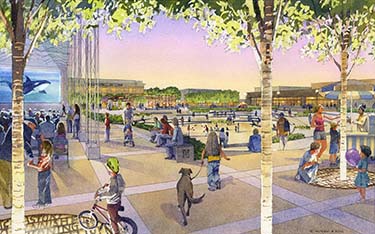|
Subscribe / Renew |
|
|
Contact Us |
|
| ► Subscribe to our Free Weekly Newsletter | |
| home | Welcome, sign in or click here to subscribe. | login |
Real Estate
| |
August 27, 2015
Astoria struggles with how to provide new housing as it gets more expensive, popular
The Daily Astorian
ASTORIA, Ore. — Anyone who has tried to rent an apartment or buy a house in Astoria since the recession knows the story: few choices, relatively high cost.
A draft affordable housing study prepared by city planners provides context that might help the City Council find solutions.
The study concluded there is a shortage of both affordable rental housing and affordable housing for sale. Rents and sales prices, while reasonable for Portland or Seattle, are too high for most middle-income families in Astoria.
Remodeling permits — in a city that celebrates historic restoration — have significantly outnumbered permits for new units.
The study's math, while striking, may have understated the challenge. The vacancy rate for the city's 4,887 housing units in 2013 was 14.3 percent, according to the U.S. Census Bureau, but property managers now put that figure closer to the single digits. The median gross rent in 2013 was $693, but property managers believe it is now closer to $850.
“The bottom line is that we are in dire need of affordable housing and maybe housing in general,” said Mike Morgan, the city's interim planner and the lead author of the draft study, which was presented to the Astoria Planning Commission Tuesday night.
The City Council, which has made affordable housing a goal, will hold a work session to discuss the study on Sept. 14.
Housing units in Astoria, according to the study, are about evenly divided between owners and renters.
City planners took the general definition of affordability — households that devote no more than 30 percent of annual income to housing — and found that 30 percent of homeowners and 45.6 percent of renters exceeded the threshold in 2013.
Surveys of property managers, community leaders and owners and renters produced similar feedback about the low vacancy rate and the need for more affordable housing.
Property managers, however, stressed the need for workforce housing, not more low-income housing.
The city does not have a solid grasp on the exact number of vacant units.
“There really is virtually zero vacancy,” said Sean Fitzpatrick, who serves on the Planning Commission and is a property manager.
The study recommends the City Council assign a task force to look at options for affordable housing and identify potential locations.
Planners also urge the city to be proactive in promoting housing development, citing the city's support for the Mill Pond project and U.S. Coast Guard housing.
The city has looked at public-private partnerships to help with new housing, including workforce housing as part of a new library at Heritage Square, but the public's appetite for subsidies has not been tested, and may not be sufficient to satisfy demand.
While city councilors and others have called on the city to address affordable housing, specific policy decisions will likely be fraught with politics.
There is vocal opposition, for example, to market-rate condominiums or other housing projects near the Columbia River, which many believe cater to second-home buyers. Neighborhoods have also balked at new housing in other pockets of the city.
Now that Astoria has become a destination, there is a backlash among some residents — including politically active transplants who moved to the city to retire — against development of any kind.
“I think we need to be creative and also a little careful that we are creating affordable housing for residents of Astoria,” said Dave Pearson, the president of the Planning Commission. “Not that we become the next Cannon Beach.”
Astoria got a $400,000 brownfields grant in 2012 to clean up the Heritage Square site at the southeast corner of 11th and Duane Streets, and also for assessing its potential uses.
The city's website said the land was used for auto repair, dry cleaning and printing since the 1920s, and later was the site of a Safeway store that was demolished in 2005, leaving a hole.
A new Chinese heritage park called the Garden of Surging Waves opened in 2014 on the northwest corner of Heritage Square, adjacent to City Hall. Suenn Ho, an urban designer from Portland, led the design team for the garden, which honors the history of Chinese people who worked in Astoria's salmon industry in the late 1800s and early 1900s.
The city's website said other portions of the Heritage Square block will be redeveloped in the future, and could include community gathering spaces and an amphitheater.
The local newspaper calls the Mill Pond project, a new urban village along the Columbia River, “Astoria's high card” because it attracted national attention for being a successful green project that also involved a cleanup.
Astoria officials want to make the Heritage Square site more enticing for developers. Contamination was found in soil during construction of the Garden of Surging Waves.



